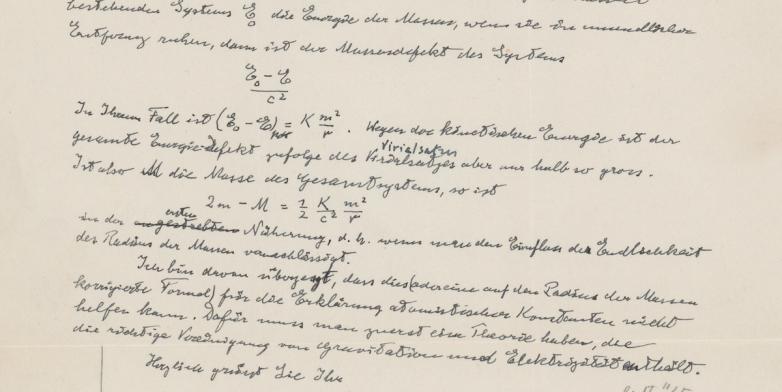Einstein Archives of Ludwik Silberstein up for Auction

Boston — RR Auction is proud to present the Einstein Archives of Ludwik Silberstein—a remarkable collection of correspondence focused on the theory of relativity.
The sale is highlighted by a rare letter in which Einstein writes his famous equation, "E = mc2," the only known example in private hands.
Everyone has seen the famous equation—it is part of the background of our lives. But how many have seen it written in Einstein’s own hand? According to archivists at the Einstein Papers Project at Caltech, and the Hebrew University of Jerusalem (where Einstein’s papers reside), only three holograph examples are known—and none of those are in private hands. This example—the fourth—is being revealed to the public for the first time.
The one-page letter in German, signed “A. Einstein,” blindstamped personal Princeton letterhead, October 26, 1946. Handwritten letter to Dr. Ludwik Silberstein, with his most famous equation, “ E = mc2,” penned in the first line in his own hand. In full (translated): “Your question can be answered from the E = mc2 formula, without any erudition. If E is the energy of your system consisting of the two masses, E0 the energy of the masses when they approach infinite distance, then the system’s mass defect is E0 - E / c2.
In this letter, written in 1946 in response to a query from Silberstein, Einstein calculates the mass difference between a system of two equal masses, m, an infinite distance from one another, and the same two masses a distance r apart, orbiting about their common center of mass. (At infinity the kinetic and gravitational potential energies both vanish, while at r, they do not. This energy difference is equivalent to a mass difference between the two configurations.) It is not a difficult exercise, and, as Einstein points out, “can be answered from the E = mc2 formula, without any erudition.”
Why the interest in such a simple system, and such a simple calculation? The answer lies in Einstein’s final paragraph: the “atomic constants” Einstein mentions are what we today refer to as the ‘fundamental’ constants—the speed of light, c, Planck’s constant, h, the gravitational constant, G, the elementary electric charge, e, and fifteen others. The values of these constants are arbitrary—they are not determined by physical theory and could conceivably have any value at all. Why they have the values they do is one of the great problems in physics—and one that Einstein thought could be explained through a “theory that contains the correct unification of gravitation and electricity.” This quest for a ‘unified field theory’ consumed the final third of Einstein’s life.
The Einstein letter is accompanied by a Biometric Art Passport as well as an NFT which ensures that the original manuscript is unforgeable and allows the owner to monitor the evolution of its condition over time.
“It’s an important letter from both a holographic and a physics point of view, as it shows Einstein’s thinking on one of the most basic of all physical problems,” said Bobby Livingston, Executive VP at RR Auction.
In Einstein's other letters, he examines a spacetime metric, writes out his gravitational field equations, and comments on the rise of Hitler and Nazism in 1934. Other featured items include many letters by Max Planck—often defending Einstein's theory of relativity —and other Nobel Prize winners, including Thomson, Bragg, Michelson, and Lorentz.
The Einstein Archives of Ludwik Silberstein auction by RR Auction begins May 13 and will conclude May 20. For more information, go to www.rrauction.com.















